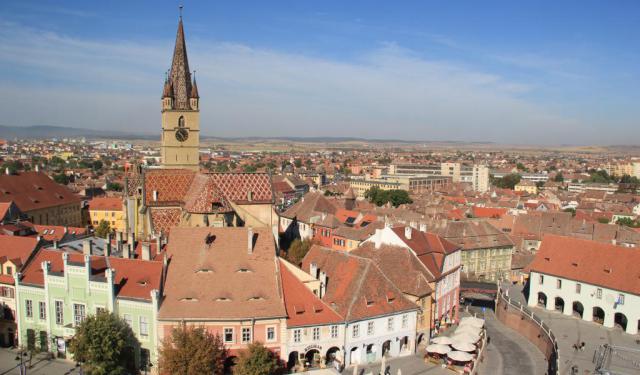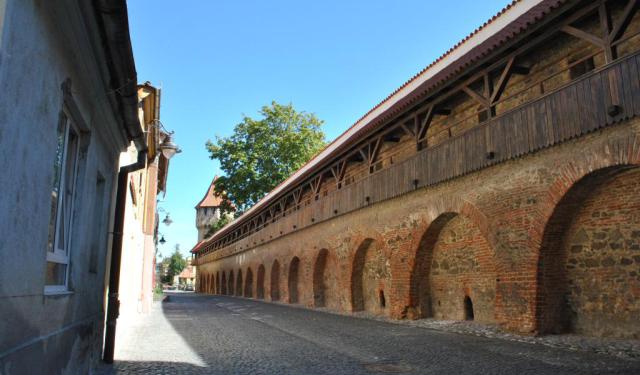
Bastionul Soldisch (Soldisch Bastion), Sibiu
The Soldisch Bastion, also known as the Bastion of the Mercenaries, stands as a formidable testament to the strategic fortifications of Sibiu. Constructed between 1622 and 1627, this bastion, located at the western extremity of Sibiu's fortifications on Bastionului Street, at the corner with Alba Iulia Road, became an integral part of the city's defensive network.
In the mid-16th century, amid the escalating threat from the Ottoman Empire, Sibiu fortified its defenses with artillery rounds and bastions. The Soldisch Bastion, along with the Haller Bastion, reflects the influence of Italian architects who introduced a new system of fortifications to counter the evolving challenges of warfare. These bastions were strategically positioned to reinforce key points in the city's defensive structure.
Constructed primarily of brick and filled with earth to enhance protection against artillery fire, the Soldisch Bastion exhibits the characteristic features of the Italian fortification system. Despite having the smallest area among the five bastions incorporated into the city's defense belts, the Soldisch Bastion boasts walls with a thickness of 2 meters and a maximum height of 10 meters.
Casemates with openings for cannons were intricately designed into the bastion's structure. Stone spacers, positioned approximately 1 meter from the upper limit of the walls, were strategically added to thwart the placement of siege stairs, enhancing the bastion's defensive capabilities. The pentagonal platform atop the bastion served as the strategic placement for cannons, contributing to the bastion's role in safeguarding the city.
Archaeological findings suggest the presence of a short tunnel beneath the Soldisch Bastion, facilitating communication beyond the walls and adding an intriguing layer to its historical significance.
Out of the five bastions constructed in the second half of the 16th century and the first half of the 17th century, including the Haller Bastion, the bastion in front of the Ocna Gate (Cobblers), the bastion in front of the Tower Gate, and the bastion in front of the Cisnădia Gate, only the Haller and Soldisch bastions have endured the test of time, preserving the rich history of Sibiu's fortifications.
In the mid-16th century, amid the escalating threat from the Ottoman Empire, Sibiu fortified its defenses with artillery rounds and bastions. The Soldisch Bastion, along with the Haller Bastion, reflects the influence of Italian architects who introduced a new system of fortifications to counter the evolving challenges of warfare. These bastions were strategically positioned to reinforce key points in the city's defensive structure.
Constructed primarily of brick and filled with earth to enhance protection against artillery fire, the Soldisch Bastion exhibits the characteristic features of the Italian fortification system. Despite having the smallest area among the five bastions incorporated into the city's defense belts, the Soldisch Bastion boasts walls with a thickness of 2 meters and a maximum height of 10 meters.
Casemates with openings for cannons were intricately designed into the bastion's structure. Stone spacers, positioned approximately 1 meter from the upper limit of the walls, were strategically added to thwart the placement of siege stairs, enhancing the bastion's defensive capabilities. The pentagonal platform atop the bastion served as the strategic placement for cannons, contributing to the bastion's role in safeguarding the city.
Archaeological findings suggest the presence of a short tunnel beneath the Soldisch Bastion, facilitating communication beyond the walls and adding an intriguing layer to its historical significance.
Out of the five bastions constructed in the second half of the 16th century and the first half of the 17th century, including the Haller Bastion, the bastion in front of the Ocna Gate (Cobblers), the bastion in front of the Tower Gate, and the bastion in front of the Cisnădia Gate, only the Haller and Soldisch bastions have endured the test of time, preserving the rich history of Sibiu's fortifications.
Want to visit this sight? Check out these Self-Guided Walking Tours in Sibiu. Alternatively, you can download the mobile app "GPSmyCity: Walks in 1K+ Cities" from Apple App Store or Google Play Store. The app turns your mobile device to a personal tour guide and it works offline, so no data plan is needed when traveling abroad.
Bastionul Soldisch (Soldisch Bastion) on Map
Sight Name: Bastionul Soldisch (Soldisch Bastion)
Sight Location: Sibiu, Romania (See walking tours in Sibiu)
Sight Type: Attraction/Landmark
Guide(s) Containing This Sight:
Sight Location: Sibiu, Romania (See walking tours in Sibiu)
Sight Type: Attraction/Landmark
Guide(s) Containing This Sight:
Walking Tours in Sibiu, Romania
Create Your Own Walk in Sibiu
Creating your own self-guided walk in Sibiu is easy and fun. Choose the city attractions that you want to see and a walk route map will be created just for you. You can even set your hotel as the start point of the walk.
Sibiu Introduction Walking Tour
Nestled in the heart of Romania's Transylvania, Sibiu is one of the most visited cities in Eastern Europe, and for a good reason! Its ancient beauty restored to its full glory in a historic center can easily steal your heart. Affectionately known as "The Town with Eyes" for its historical buildings with partly open rooftops, the city beckons travelers with its captivating... view more
Tour Duration: 2 Hour(s)
Travel Distance: 2.0 Km or 1.2 Miles
Tour Duration: 2 Hour(s)
Travel Distance: 2.0 Km or 1.2 Miles
Sibiu City Wall and Towers Walking Tour
The historical fortifications of Sibiu hold significant heritage value, offering insights into the city's past and its enduring efforts to protect itself. Unfortunately, for many years, these sites were inaccessible to visitors. Along Fortress Street (Strada Cetății), a collection of towers is linked by a guard corridor, a rare and precious feature that remains the sole example of its kind... view more
Tour Duration: 1 Hour(s)
Travel Distance: 1.9 Km or 1.2 Miles
Tour Duration: 1 Hour(s)
Travel Distance: 1.9 Km or 1.2 Miles


